
Tiny temperature variations found in maps of the cosmic microwave background are commonly thought to be proof that stars, galaxies and other large-scale structures grew from density perturbations in the early universe. But one physicist in the US is controversially claiming that these observed variations are in fact caused by hydrogen atoms in our own galaxy. If he is right, cosmologists will have to drastically rethink their models of the universe’s evolution.
In the early universe’s hot plasma, light left over from the Big Bang could not travel far without being scattered by electrons. But by the time the universe was some 380,000 years old, it had cooled enough to let electrons and protons combine and form hydrogen atoms. Photons could then travel freely over long distances without being scattered, stretching in wavelength as the universe expanded to become the cosmic microwave background (CMB) — a map of the early universe’s structure frozen in time.
Data taken by the COBE satellite in 1993, and to a greater extent by the Wilkinson Microwave Anisotropy Probe (WMAP) in 2003, showed that tiny temperature variations permeated the CMB. These proved that the early universe was not an even distribution of mass, but had dense regions that — as cosmologists’ models suggest — were to seed the galaxies and other structures we see today.
Wrong source
Gerrit Verschuur, a physicist from the University of Memphis in the US, disagrees. He has noticed that the temperature variations recorded by WMAP tend to coincide with radio emissions from neutral hydrogen in the Milky Way. In other words, the fluctuations may not be part of the CMB at all (Astro. J. in publication; preprint available at arXiv.org:0704.1125v2).
My approach now is to determine what I can learn about interstellar physics in studying these cases, and not to worry about statistical arguments
Verschuur made his discovery while studying the Leiden-Argentina-Bonn (LAB) survey, a map of radio emissions from neutral hydrogen in the Milky Way that was completed for the entire sky in 2005. “So many data are daunting and users of the all-sky LAB survey still tend to extract only the data for the small area they are interested in,” he told physicsworld.com. “I had been working with the data over a large area.” In his paper Verschuur notes six areas where he has found visual correlations between the LAB and WMAP surveys, though he says that he has since found around 200 more correlated areas.
If his analysis is correct, it would undermine the widely established “cold dark matter” model of the universe’s evolution, which says that large-scale structure grew from small density perturbations in the early universe. According to studies of the WMAP survey, normal matter makes up just 4% of the universe, with mysterious dark matter and dark energy accounting for 24% and 72%, respectively. Although WMAP scientists had to carefully subtract known contributions from physical processes in the Milky Way, Verschuur points out that the correlating hydrogen emissions could be originating from an unidentified process.
Statistical analysis
Not everyone agrees with the US physicist’s inferences, however. Kate Land at the University of Oxford in the UK and Anže Slosar at the University of Ljubljana in Slovenia compared various maps from the LAB and WMAP surveys at different frequency bands and scales using computer “Monte Carlo” techniques, but found no statistically significant correlations (Phys. Rev. D 76 087301).
The results are somewhat anecdotal
As for the reliability of visual inspections, Land and Slosar recall the urban myth that a certain point in the WMAP survey contains Stephen Hawking’s initials. “Correlations by eye are very misleading,” they conclude.
Undeterred
Even so, Verschuur is keen to continue his analyses. “My approach now is to determine what I can learn about interstellar physics in studying these cases, and not to worry about statistical arguments,” he said.
But Gary Hinshaw, a physicist on the WMAP mission team at NASA’s Goddard Space Flight Centre, also disputes Verschuur’s conclusions. “My impression is that it is primarily based on a visual comparison of the maps and not on a rigorous statistical analysis, so the results are somewhat anecdotal,” he told physicsworld.com. Referring to the study by Land and Slosar, he added: “I think this paper really puts the claim to rest.”



